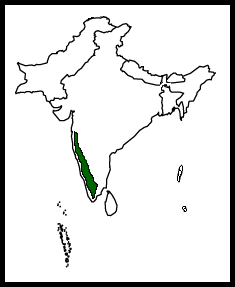- Ocyceros griseus
Identification
45cm (17¾ in)
- Brownish-grey wings
- Black primaries
- Grey back
- Whitish crown
- Long black, white-tipped tail
- White underparts
- Long curved bill.
Sexes are similar, but the male has an orange bill, whereas the female's is smaller and yellow. Immature birds have browner upperparts and a yellow bill.
Similar Species
Only species to confuse with is the Indian Grey Hornbill Ocyceros birostris but note the lack of a casque and the black tail of the Malabar Grey Hornbill.
Distribution
| South west India from Maharashtra (Mumbai) south to Kerala, mainly in the plains but up to 1600m. A Western Ghats endemic. Locally common but suffering from habitat loss. | |
| Legend |
Taxonomy
A member of the Hornbill family Bucerotidae and one of the three species of the genus Ocyceros, sometimes also placed in Tockus. Sri Lanka Grey Hornbill Ocyceros gingalensis is sometimes included in this species.
This is a monotypic species[1].
Habitat
Broadleved evergreen and moist deciduous forest. Sometimes in gardens and plantations.
Behaviour
Usually found in the middle storey in small groups. Sometimes together with other frugivorous species like green pigeons or bulbuls. Often quite inconspicuous and allows close approaching.
Diet
Their main diet consists of fruits such as figs, though they also eats small rodents, reptiles and insects.
Breeding
The clutch contains up to 4 white eggs. These are laid in a tree hole, which is then blocked off trapping the female inside while she incubates the eggs. The male feeds her through a small gap.
Incubation of the eggs takes around 40 days, with fledging occurring some 46 days later, when the female breaks out
References
- Clements, J. F., T. S. Schulenberg, M. J. Iliff, S. M. Billerman, T. A. Fredericks, B. L. Sullivan, and C. L. Wood. 2019. The eBird/Clements Checklist of Birds of the World: v2019. Downloaded from http://www.birds.cornell.edu/clementschecklist/download/
- Rasmussen, P.C. and Anderton, J.C. 2005. Birds of South Asia. The Ripley Guide. Washington D.C. and Barcelona: Smithsonian Institution and Lynx Editions. ISBN 84-87334-67-9
- Grimmett, R., Inskipp, C. and Inskipp, T. 1998. Birds of the Indian Subcontinent. London: Christopher Helm. ISBN 0-7136-4004-9
- Kazmierczak, K. and Singh, R. 2001: A Birdwatcher's Guide to India. New Dehli: Oxford University Press. ISBN 019-565285-1
Recommended Citation
- BirdForum Opus contributors. (2024) Malabar Grey Hornbill. In: BirdForum, the forum for wild birds and birding. Retrieved 10 May 2024 from https://www.birdforum.net/opus/Malabar_Grey_Hornbill
External Links
Search the Gallery using the scientific name:
Search the Gallery using the common name:







